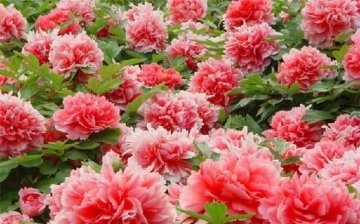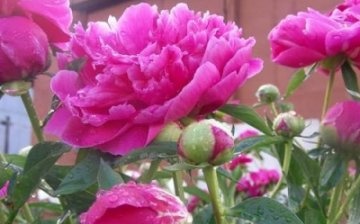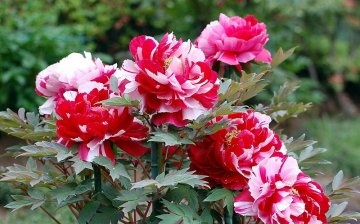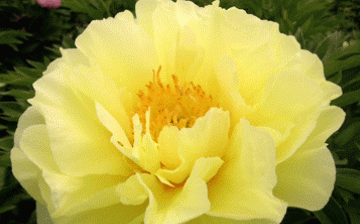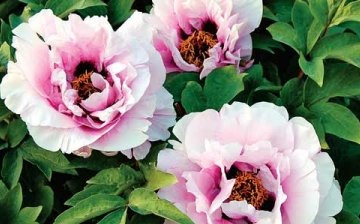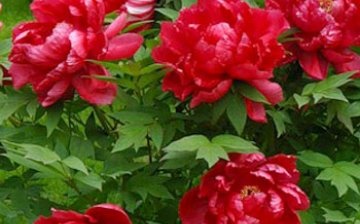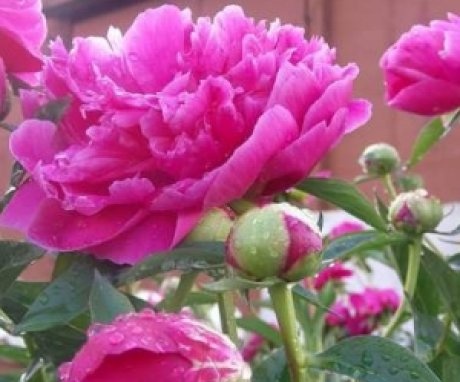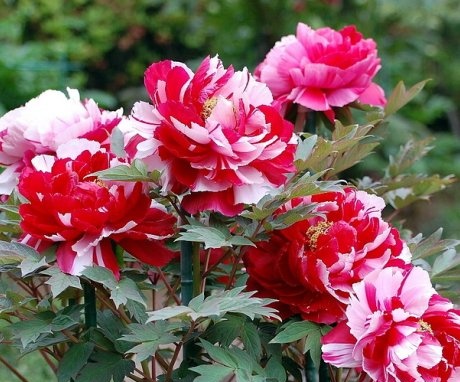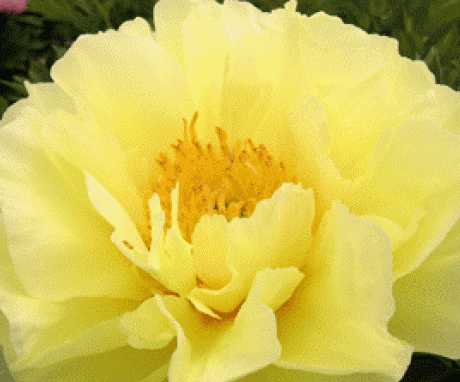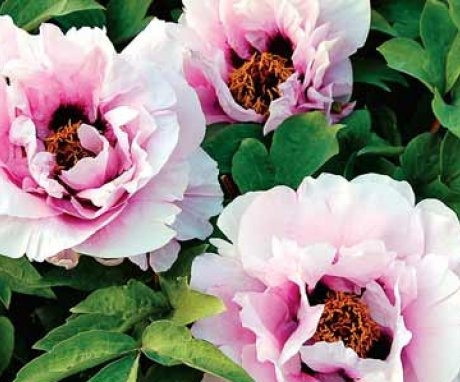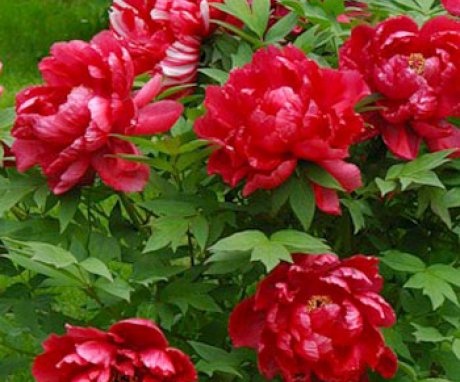Characteristics of varieties of tree peony
Peony is one of the most beautiful and most beloved flowers of all gardeners. For his external data, the people also call him "the king of flowers".
Content:
- Characteristics of the tree peony
- European-Chinese group of varieties
- Delaway peony and yellow peony hybrids
- Japanese group
- Recommendations for combining varieties with other plants
Characteristics of the tree peony
For several years now peonies confidently dictate flower fashion... They succeeded in the incredible: spectacular plants pushed the eternal leader - rose... If you not only decorate the house with bouquets, but also dream of setting up luxurious thickets of bushes in the garden, completely covered with large flowers, then you should pay attention to the group of tree-like peonies.
They differ from herbaceous perennials in that they belong to bush plants.
Unlike traditional peonies, the leaves of the tree-like peonies fall off in the fall. Only the trunk of the bush is preserved. While in herbaceous, it completely dies off, and in the spring, a part located on the soil surface germinates again.
The largest collection of this type is found in China, the birthplace of the plant.
Already in ancient times, the Chinese compiled a detailed guide to caring for a tree culture, also describing the technique breeding new varieties... Undoubtedly, the best types of peonies belong to the ancestors of the plant. Cultures are successfully bred in Japan.
Classification of tree varieties
An interesting fact is that in the homeland, tree-type peonies are revered much more than herbaceous ones.
Euro-China Group
Features of this type of peony:
- Flowers of the European-Chinese group are double.
- They are large in size.
- Petals can be white, lilac, crimson.
- The hallmark of this group of plants is a bright spot, usually pink. It is located at the base of a peony petal.
- Large flowers look very impressive, but due to their weight they quickly disappear.
Delaway peony and yellow peony hybrids
The youngest, but at the same time the most popular group among flower growers. The reason for the success lies in the yellow shade, which is rare for peonies. In addition, the family of herbaceous relatives practically does not have the colors of this range.
Therefore, the current direction of selection is the crossing of peonies of this group with representatives of herbaceous ones.
Such hybrids are varieties with the best qualities of both types:
- So, the shape of the bush is more reminiscent of herbaceous plants, while the petals, in their texture, pattern, as well as the color of the leaves, inherited the features of tree-like ones. For example, the petals retained spots at the base.
- The shoots of peonies are strong, do not fall to the ground, and, therefore, do not require props.
- The duration of flowering is increased due to the presence of lateral buds. Moreover, in size and decorativeness, they are not inferior to the main flowers.
- The hybrids are drought tolerant.
- Among them there are as garden varieties, especially well located in a natural park composition, and varieties suitable for cutting.
- The size of the bushes is slightly smaller than that of the plants of the European group. On average, their height is 80 cm.
In addition to yellow flowers, there are white and red hybrids.
It should be noted that hybrids bred in China do not take root well in the Russian climate. But Russian breeders are quite active in breeding varieties adapted to local weather conditions. To date, an impressive collection of tree peonies has already been collected, distinguished by a variety of colors and shapes. The varieties that can be grown in Siberia have been bred. These peonies are characterized by increased resistance to frost.
Japanese group
The varieties of the Japanese group are smaller, and, therefore, lighter. In addition, peonies have a stronger stem and peduncle. A characteristic feature of flowers is their noticeable rise above the leaves. The petals can be either semi-double or not double at all.
A feature of treelike peonies is their very long growth. So, flowering bushes can sometimes come only after a few years. To increase the rate of development, plant cuttings are grafted onto a herbaceous rootstock.
Peony tree varieties Hatsugarasu (Hatsugarasu)
- The variety belongs to the group of black peonies.
- Semi-double petals of inflorescences are painted in a deep, dark red hue.
- The outer row has white specks.
- The petals are concave, semicircular.
- They are dense to the touch and have wavy ends.
- The flower diameter is 20 cm.
This variety should be planted in the second half of spring. It is imperative to leave a distance of about one meter between the bushes.
- Hatsugarasu is planted to a depth of 10 cm.
- Peonies of this variety usually bloom from April to July, reaching a height of one and a half meters.
Peony variety Silver Red
- Peonies of this species are characterized by relatively fast growth.
- Flowers resemble chrysanthemum.
- The peony blooms profusely, from April to June.
- The flowers are 12 cm in diameter.
- The color of the petals is delicate pink, smoothly turning to the center in bright red.
- By form resemble a rose.
- The stems are characterized by elasticity and great thickness.
- Peonies of this species exude a special, delicate aroma.
- Planting features are the same as those of the Hatsugarasu variety.
Peony variety Champion Black Jade
- One of the most beautiful varieties of peonies.
- Named after the wife of the emperor of China. In history, she is known as the most beautiful woman in the Middle Kingdom.
- This type of tree peony is perennial.
- It is distinguished by its high growth - the length of the plant reaches two meters.
- The leaves have purple tips. Wine-colored double petals.
Peony cultivar Shima-nishiki
- Another variety of very popular peonies.
- The species originated from a mutation of another well-known variety, Tayo.
- They attract florists with their diversity.
- The flowers are red and white. The alternation is chaotic.
- This type of plant is planted in May.
- Peony blooms in the middle of the summer season.
Peony variety Kinkaku
- Large flowers of this type are similar to Sicilian oranges: yellow-orange petals turn red towards the center.
- Surprisingly, peonies also have a citrus aroma, with a lemon note.
- This type of shrub is of medium size and does not exceed 80 cm.
- The buds open closer to the middle of the season.
Recommendations for combining varieties with other plants
Peony varieties characterized by large bushes are recommended plant one by one... So, located next to the gazebo or terrace, the peony will become a spectacular decoration of the recreation area. For these purposes, it is better to choose varieties with an unusual, curved line of the silhouette of the leaves. Varieties with a relatively low height are usually used as a border, to highlight the boundaries of flower beds, to frame roads.
Peony varieties with dark red flowers go well with conifers.
Moreover, the tandem is successful in terms of perfume composition: the base heavy aroma of spruce resin is perfectly set off by the airy-ephemeral subtlety of peony. Moreover, now the trend is the emphasis on the fragrance of the garden. Peonies get along well with ornamental bushes such as elderberry.You can plant trees next to clematis.
Thus, from the whole variety of shapes, colors of flowers and leaves, you can choose the most suitable varieties, taking into account the features of the landscape design of the garden. Taking into account the high cost of varietal seedlings, it is advisable to start breeding your favorite varieties of tree peony yourself.
More information can be found in the video.



